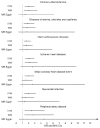Sodium intake and the risk of various types of cardiovascular diseases: a Mendelian randomization study
- PMID: 38188872
- PMCID: PMC10771828
- DOI: 10.3389/fnut.2023.1250509
Sodium intake and the risk of various types of cardiovascular diseases: a Mendelian randomization study
Abstract
Background: The existing literature on the link between sodium intake and cardiovascular disease (CVD) largely consists of observational studies that have yielded inconsistent conclusions. In this study, our objective is to assess the causal relationship between sodium intake and 50 CVDs using two-sample Mendelian randomization (MR) analysis.
Methods: MR analyses were performed to investigate the associations between urinary sodium/creatinine ratio (UNa/UCr), an indicator of sodium intake, and 50 CVDs. The genome-wide association study (GWAS) for UNa/UCr was from the UK Biobank (UKBB), and the GWASs for CVDs were from FinnGen. A false discovery rate (FDR) threshold of 5% was applied for multiple comparison correction.
Results: The inverse-variance weighted method indicated that the genetically predicted UNa/UCr was significantly associated with 7 of 50 CVDs, including "Coronary atherosclerosis" (OR = 2.01; 95% CI: 1.37, 2.95), "Diseases of arteries, arterioles and capillaries" (OR = 1.88; 95% CI: 1.20, 2.94), "Hard cardiovascular diseases" (OR = 1.71; 95% CI: 1.24, 2.35), "Ischemic heart diseases" (OR = 2.06; 95% CI: 1.46, 2.93), "Major coronary heart disease event" (OR = 1.99; 95% CI: 1.36, 2.91), "Myocardial infarction" (OR = 2.03; 95% CI: 1.29, 3.19), and "Peripheral artery disease" (OR = 2.50; 95% CI: 1.35, 4.63). Similar results were obtained with the MR-Egger and weighted median methods. No significant heterogeneity or horizontal pleiotropy was found in this analysis.
Conclusion: Our study has uncovered a significant positive causal relationship between UNa/UCr and various CVDs. These results offer a new theoretical foundation for advocating the restriction of sodium intake as a preventive measure against CVD.
Keywords: FinnGen; Mendelian randomization; UK Biobank; cardiovascular disease; sodium intake.
Copyright © 2023 Fu, Chen, Ding, Xu, Huang, He, Jiang, Zeng, Bao and Li.
Conflict of interest statement
The authors declare that the research was conducted in the absence of any commercial or financial relationships that could be construed as a potential conflict of interest.
Figures





Similar articles
-
Causal associations between type 1 diabetes mellitus and cardiovascular diseases: a Mendelian randomization study.Cardiovasc Diabetol. 2023 Sep 2;22(1):236. doi: 10.1186/s12933-023-01974-6. Cardiovasc Diabetol. 2023. PMID: 37659996 Free PMC article.
-
Mendelian Randomization Analysis Reveals a Causal Effect of Urinary Sodium/Urinary Creatinine Ratio on Kidney Function in Europeans.Front Bioeng Biotechnol. 2020 Jul 7;8:662. doi: 10.3389/fbioe.2020.00662. eCollection 2020. Front Bioeng Biotechnol. 2020. PMID: 32733862 Free PMC article.
-
A causal relationship between irritability and cardiovascular diseases: a Mendelian randomization study.Front Cardiovasc Med. 2023 May 30;10:1174329. doi: 10.3389/fcvm.2023.1174329. eCollection 2023. Front Cardiovasc Med. 2023. PMID: 37324625 Free PMC article.
-
Association Between Atopic Dermatitis and Major Cardiovascular Outcomes: a Two-Sample Mendelian Randomization Study.Dermatol Pract Concept. 2022 Oct 1;12(4):e2022165. doi: 10.5826/dpc.1204a165. eCollection 2022 Nov. Dermatol Pract Concept. 2022. PMID: 36534570 Free PMC article. Review.
-
The Application of Mendelian Randomization in Cardiovascular Disease Risk Prediction: Current Status and Future Prospects.Rev Cardiovasc Med. 2024 Jul 11;25(7):262. doi: 10.31083/j.rcm2507262. eCollection 2024 Jul. Rev Cardiovasc Med. 2024. PMID: 39139440 Free PMC article. Review.
Cited by
-
Advancements in tissue engineering for cardiovascular health: a biomedical engineering perspective.Front Bioeng Biotechnol. 2024 May 31;12:1385124. doi: 10.3389/fbioe.2024.1385124. eCollection 2024. Front Bioeng Biotechnol. 2024. PMID: 38882638 Free PMC article. Review.
-
Assessing causal associations of bile acids with obesity indicators: A Mendelian randomization study.Medicine (Baltimore). 2024 Jun 21;103(25):e38610. doi: 10.1097/MD.0000000000038610. Medicine (Baltimore). 2024. PMID: 38905395 Free PMC article.
-
Mechanisms of inflammatory microenvironment formation in cardiometabolic diseases: molecular and cellular perspectives.Front Cardiovasc Med. 2025 Jan 14;11:1529903. doi: 10.3389/fcvm.2024.1529903. eCollection 2024. Front Cardiovasc Med. 2025. PMID: 39877020 Free PMC article. Review.
-
Causal associations between HbA1c and multiple diseases unveiled through a Mendelian randomization phenome-wide association study in East Asian populations.Medicine (Baltimore). 2025 Mar 14;104(11):e41861. doi: 10.1097/MD.0000000000041861. Medicine (Baltimore). 2025. PMID: 40101035 Free PMC article.
-
Environmental endocrine disruptor-induced mitochondrial dysfunction: a potential mechanism underlying diabetes and its complications.Front Endocrinol (Lausanne). 2024 Aug 15;15:1422752. doi: 10.3389/fendo.2024.1422752. eCollection 2024. Front Endocrinol (Lausanne). 2024. PMID: 39211449 Free PMC article. Review.
References
-
- World Health Organization . Noncommunicable Diseases. Available from: https://www.who.int/news-room/fact-sheets/detail/noncommunicable-diseases (accessed September 16, 2022).
LinkOut - more resources
Full Text Sources

